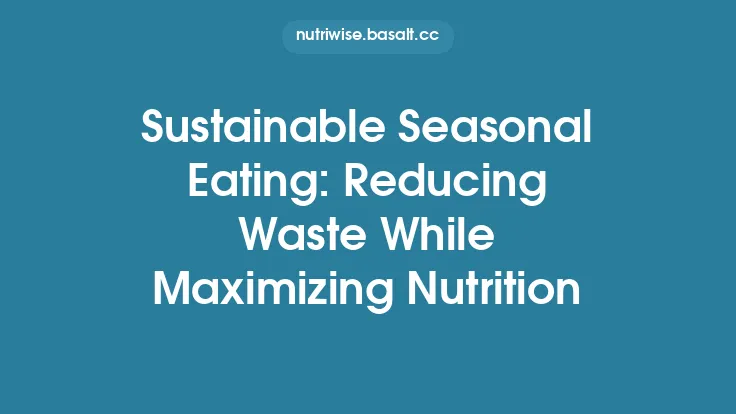Seasonal meal planning is more than a trendy buzzword; it’s a practical, evergreen strategy that lets you enjoy the freshest flavors while keeping your grocery bill in check. By aligning your menu with the natural rhythm of produce availability, you can tap into lower prices, superior taste, and higher nutritional value—all without sacrificing variety or convenience. Below is a comprehensive guide that walks you through the why, what, and how of seasonal meal planning, offering actionable insights that remain relevant year after year.
Understanding Seasonal Produce Cycles
1. The science of seasonality
Plants grow best when temperature, daylight hours, and precipitation align with their genetic requirements. When a fruit or vegetable is “in season,” it is harvested at peak ripeness, which translates to:
- Higher sugar and nutrient concentrations – photosynthesis is most efficient, leading to richer flavor and more vitamins.
- Lower post‑harvest handling costs – less need for artificial ripening, refrigeration, or long‑distance transport.
2. Regional variations
Seasonality is not universal; it depends on climate zones. A useful starting point is to consult a regional “seasonal guide” (often published by local agricultural extensions or university horticulture departments). These guides list the months when each crop is at its prime in your area, helping you avoid the temptation to buy out‑of‑season produce that arrives with a higher price tag.
3. The “peak” vs. “shoulder” periods
- Peak season: The month(s) when a crop is most abundant. Prices are typically lowest, and quality is highest.
- Shoulder season: The months just before or after peak. Produce is still relatively fresh, but supply begins to taper, causing a modest price increase. Planning meals around both peak and shoulder periods maximizes flexibility while still capturing most of the cost savings.
Creating a Seasonal Meal Calendar
1. Map the year in four quarters
Divide the calendar into Spring, Summer, Autumn, and Winter. For each quarter, list the top 8–10 vegetables and fruits that are at their peak. Example (Mid‑Atlantic U.S.):
- Spring: Asparagus, peas, radishes, strawberries, rhubarb, spinach, lettuce, new potatoes.
- Summer: Tomatoes, zucchini, corn, berries, peaches, cucumbers, bell peppers, beans.
- Autumn: Squash, apples, carrots, Brussels sprouts, kale, pears, beets, sweet potatoes.
- Winter: Citrus, root vegetables (parsnips, turnips), cabbage, leeks, pomegranates, collard greens, persimmons.
2. Assign “theme weeks”
Instead of planning each day individually, choose a weekly theme that revolves around a dominant seasonal ingredient. For instance, “Root‑Vegetable Week” in late autumn can feature carrot soup, roasted parsnip salad, and beet‑infused grain bowls. This approach reduces decision fatigue and streamlines grocery lists.
3. Build in “flex weeks”
Allocate one or two weeks per season where you intentionally keep the menu open-ended. Use these periods to experiment with new recipes, test emerging market deals, or incorporate any unexpected surplus from local farms. Flex weeks act as a buffer, preventing the plan from feeling overly rigid.
Cost Analysis of Seasonal vs. Out‑of‑Season Ingredients
1. Direct price comparison
Collect price data for a set of staple items (e.g., tomatoes, broccoli, berries) over a 12‑month period. Plot the average cost per pound against the month of purchase. You’ll typically see a “U‑shaped” curve: low prices during peak months, rising sharply during off‑season periods.
2. Hidden costs of out‑of‑season produce
- Transportation & storage: Out‑of‑season items often travel long distances, incurring fuel and refrigeration expenses that are reflected in the retail price.
- Quality depreciation: Produce harvested early and ripened artificially may require additional processing (e.g., peeling, trimming), which can increase preparation time and waste.
- Nutrient loss: Longer storage can diminish vitamin content, meaning you may need larger portions to achieve the same nutritional benefit.
3. Break‑even point
If a seasonal vegetable costs $1.20 per pound in June and $2.80 per pound in December, the price differential is $1.60. Assuming you use 2 lb per week, the extra cost for a single out‑of‑season week is $3.20. Over a year, these incremental differences add up, making seasonal alignment a clear money‑saving tactic.
Building a Flexible Core Pantry for Seasonal Menus
A well‑stocked pantry provides the foundation for quick, adaptable meals that can incorporate whatever fresh produce is in season.
| Category | Core Items | Seasonal Pairings |
|---|---|---|
| Grains | Brown rice, quinoa, farro, whole‑wheat pasta | Spring peas, Summer corn, Autumn squash, Winter root vegetables |
| Legumes | Dried lentils, chickpeas, black beans | Spring spinach, Summer tomatoes, Autumn kale, Winter carrots |
| Nuts & Seeds | Almonds, sunflower seeds, chia, flax | Pair with fresh fruit salads or roasted vegetable bowls |
| Shelf‑stable aromatics | Canned tomatoes, broth, dried herbs (thyme, oregano, bay leaves) | Enhance sauces for seasonal vegetables |
| Healthy fats | Olive oil, avocado oil, coconut milk | Drizzle over roasted produce or blend into soups |
By keeping these staples on hand, you can quickly assemble a balanced plate once the seasonal produce arrives, without needing to purchase a new set of pantry items each month.
Cooking Techniques that Highlight Fresh Seasonal Flavors
1. Light roasting – Roasting at 375–400 °F caramelizes natural sugars while preserving texture. Ideal for root vegetables in autumn and summer squash. Toss with a minimal amount of oil and a pinch of sea salt to let the produce shine.
2. Quick sauté – High‑heat sautéing (2–4 minutes) retains crispness in spring greens like arugula or baby kale. Finish with a splash of citrus juice to accentuate freshness.
3. Steaming with aromatics – Steaming broccoli or asparagus with a sprig of dill or a slice of ginger infuses subtle flavor without masking the vegetable’s natural taste.
4. Grilling – Direct heat adds smoky depth to summer tomatoes, corn, and bell peppers. Brush lightly with herb‑infused oil to prevent sticking and enhance aroma.
5. Raw preparations – Many spring and early summer produce (radishes, snap peas, berries) are at their peak when eaten raw. Simple salads with a vinaigrette made from seasonal citrus keep the dish vibrant and cost‑effective.
Preserving Seasonal Harvests for Year‑Round Use
While the focus is on fresh consumption, strategic preservation extends the financial benefits of a good seasonal harvest.
1. Simple blanch‑freeze method
- Blanch vegetables (e.g., green beans, carrots) in boiling water for 2–3 minutes.
- Shock in ice water to halt cooking.
- Dry thoroughly, then pack in airtight freezer bags, removing as much air as possible.
Freezing preserves texture and nutrients better than canning for most vegetables, and it requires minimal equipment.
2. Fermentation
Seasonal cabbage, carrots, and radishes can be turned into sauerkraut or kimchi. Fermentation not only extends shelf life but also adds probiotic benefits. A basic brine (1 tbsp salt per 1 cup water) and a clean jar are all you need.
3. Dehydration
Thinly slice fruits (apples, peaches) and vegetables (tomatoes, zucchini) and dry them at low temperature (115–135 °F). Dehydrated produce can be rehydrated for soups or used as crunchy snacks, reducing waste and providing a low‑cost pantry staple.
Smart Shopping Strategies Aligned with Seasonal Peaks
1. Monitor local market reports
Many regional agricultural extensions publish weekly “crop reports” that indicate which farms have surplus yields. When a particular crop is abundant, growers often lower prices to move inventory quickly.
2. Use price‑tracking apps
Some grocery‑store apps allow you to set alerts for specific items. Set alerts for your seasonal staples; when the price drops to a target level, you’ll know it’s a good time to stock up.
3. Buy in modest bulk for immediate use
While bulk buying is a separate topic, purchasing a slightly larger quantity of a seasonal item (e.g., a 2‑lb bag of fresh peas) when it’s on sale can be economical, provided you have a plan to use or preserve the excess within a few days.
4. Leverage “sale cycles”
Supermarkets often rotate promotional themes (e.g., “Tomato Week”). Align your meal calendar with these cycles to capture discounts without compromising your seasonal focus.
Integrating Seasonal Herbs and Spices for Flavor and Savings
Fresh herbs are the unsung heroes of seasonal cooking. They are typically inexpensive when in season and can dramatically reduce the need for costly packaged sauces.
- Spring: Mint, chives, parsley – perfect for brightening salads and grain bowls.
- Summer: Basil, dill, cilantro – ideal for pesto, vinaigrettes, and grilled vegetables.
- Autumn: Sage, rosemary, thyme – add depth to roasted root vegetables and stews.
- Winter: Bay leaves, winter thyme, oregano – enhance soups and braised dishes.
Grow a small herb window box or use a countertop pot; the initial investment is minimal, and the ongoing harvest provides a continuous, low‑cost flavor boost.
Evaluating the Environmental and Health Benefits of Seasonal Eating
1. Reduced carbon footprint
Transporting out‑of‑season produce across continents consumes significant fuel and refrigeration energy. By choosing locally in‑season items, you cut down on greenhouse‑gas emissions associated with long‑haul logistics.
2. Lower pesticide load
Seasonal crops are often grown in their natural climate, reducing the need for chemical interventions. While not a guarantee, the likelihood of lower pesticide residues is higher compared with out‑of‑season produce that may require intensive treatments to survive transport.
3. Enhanced nutrient density
Studies consistently show that produce harvested at peak ripeness contains higher levels of vitamins (e.g., vitamin C, carotenoids) and antioxidants. Consuming these nutrients supports immune function, skin health, and overall well‑being.
4. Psychological satisfaction
Eating foods that reflect the current season can improve meal satisfaction and encourage mindful eating. The visual appeal of vibrant, fresh produce often leads to smaller portion sizes and reduced overall caloric intake, indirectly supporting a healthier budget.
Putting It All Together: A Sample Seasonal Meal Plan (Spring)
| Day | Breakfast (optional) | Lunch | Dinner | Seasonal Highlight |
|---|---|---|---|---|
| Mon | – | Quinoa salad with snap peas, radishes, and mint | Lemon‑garlic roasted chicken with asparagus and new potatoes | Asparagus, snap peas |
| Tue | – | Lentil soup with carrots and fresh thyme | Pan‑seared salmon with a strawberry‑balsamic glaze, served over wilted spinach | Strawberries, spinach |
| Wed | – | Whole‑grain wrap with hummus, cucumber, and fresh dill | Stir‑fried tofu with spring onions, peas, and a light soy‑ginger sauce | Peas, spring onions |
| Thu | – | Chickpea and arugula salad with lemon vinaigrette | Pasta primavera featuring zucchini, cherry tomatoes, and fresh basil | Zucchini, basil |
| Fri | – | Mixed greens with radish, avocado, and a citrus dressing | Grilled pork chops with a side of roasted carrots and a parsley‑pepper sauce | Carrots, parsley |
| Sat | – | Open‑faced rye toast topped with ricotta, sliced strawberries, and a drizzle of honey | Vegetable frittata packed with leeks, spinach, and chives | Leeks, strawberries |
| Sun | – | Cold grain bowl with farro, peas, mint, and a yogurt‑herb dressing | Slow‑cooked lamb shank with a rosemary‑infused broth, served with sautéed kale | Mint, rosemary |
*Note: Breakfast is omitted to keep the focus on lunch and dinner, but the same seasonal principles can be applied to any morning meal.*
Final Thoughts
Seasonal meal planning is a timeless strategy that intertwines financial prudence, culinary enjoyment, and environmental stewardship. By understanding the natural cycles of produce, mapping those cycles onto a flexible calendar, and employing smart cooking and preservation techniques, you can consistently enjoy fresh, vibrant meals without inflating your grocery bill. The approach is adaptable—whether you live in a bustling city with weekly farmers’ markets or a suburban area with a well‑stocked grocery store—because the core principle remains the same: let nature dictate what’s on your plate, and let your wallet reap the benefits.





